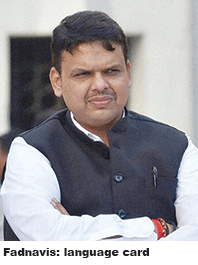 The bjp-shiv sena coalition government of Maharashtra is under strain following the embarrassment caused to the administration by Sena cadres running amok in Mumbai, forcing the BCCI to withdraw Pakistani commentators and umpires from the on-going India-South Africa cricket series, and blackening the face of writer-journalist Sudheendra Kulkarni. Uddhav Thackeray, the Shiv Sena supremo, has publicly dared Maharashtra chief minister Devendra Fadnavis to break off the BJP-Sena alliance, forcing the latter to issue a media statement on October 12 to reaffirm his commitment to the alliance which swept the Maharashtra (pop.112 million) legislative assembly polls exactly a year ago.
The bjp-shiv sena coalition government of Maharashtra is under strain following the embarrassment caused to the administration by Sena cadres running amok in Mumbai, forcing the BCCI to withdraw Pakistani commentators and umpires from the on-going India-South Africa cricket series, and blackening the face of writer-journalist Sudheendra Kulkarni. Uddhav Thackeray, the Shiv Sena supremo, has publicly dared Maharashtra chief minister Devendra Fadnavis to break off the BJP-Sena alliance, forcing the latter to issue a media statement on October 12 to reaffirm his commitment to the alliance which swept the Maharashtra (pop.112 million) legislative assembly polls exactly a year ago.
Moreover, in a move to smooth the ruffled feathers of the parochial Shiv Sena, which regards all non-Marathi speaking citizens as ‘outsiders’, the state government has proposed to extend the teaching of Marathi in the state’s 800 private unaided schools affiliated with the pan-India CBSE, CISCE and international exam boards.
On October 16, education minister Vinod Tawde, informed the media that the state government intends to make it mandatory for CBSE, CISCE, CIE (UK) and IBO (Geneva)-affiliated schools in Maharashtra to teach Marathi in classes I-VIII, and Maharashtra’s history and geography up to class V. He announced the setting up of a 13-member coordination committee comprising ten representatives from these exam boards and three from the state government to draw up a detailed implementation plan.
Currently, while the state’s 85,000 government and aided private schools affiliated with the Maharashtra State Board of Secondary and Higher Secondary Education teach Marathi from classes I-X, schools affiliated with the CBSE/CISCE and offshore IBO (Geneva) and CIE (UK) boards are obliged to teach Marathi from classes I-IV. All non-state board-affiliated greenfield schools in Maharashtra are awarded the all-important ‘no-objection certificate’ from the state government only if they agree to teach Marathi for at least four years.
The populist language card played by Fadnavis out of political desperation is likely to complicate school curriculums and impose additional strain on primary students already struggling with weighty syllabuses and shoddily written textbooks.
However it’s pertinent to note that this proposal is in consonance with the three language formula proposed way back in 1966 by the Kothari Commission which recommended that children learn each state’s official language, Hindi (the national language) and English (the link language). Therefore, the extension of Marathi learning till the end of elementary education (class VIII) for all children studying in the state has been welcomed by informed educationists despite its populist motivation.
“The local language, history and geography should be part of the school curriculum. I have studied the curriculums of other countries and most of them prescribe this combination in primary education. A child is likely to be well-grounded if she is acquainted with her local environment and culture,” says Swati Popat Vats, the Mumbai-based director of Podar Institute of Education and president of the Early Childhood Association of India.
The state government’s proposal to extend compulsory learning of Marathi to class VIII has also drawn positive response from CBSE/CISCE-affiliated school managements. “I am in favour of this initiative. In four years, a child is able to read and write but has a very basic understanding of what she has learned and tends to forgets what has been taught. But if they learn Marathi until class VIII, they will retain their knowledge of the state’s official language,” says J. Mohanty, principal of the CBSE-affiliated Delhi Public School, Navi Mumbai.
In addition, a good grounding in Marathi will stand students in good stead when interacting with the local population — especially from the rural hinterland — who are unlikely to have learned the national or link languages, and will also ease the entry of migrants into the state aspiring for careers in civil administration. Most job opportunities in the state government stipulate Marathi proficiency of the level of class VII.
Although somewhat sceptical about the motivation and timing of the state government’s Marathi teaching initiative, educationists in Mumbai are appreciative that chief minister Fadnavis is cautiously implementing this proposal with the cooperation of CBSE, CISCE and international schools, and has appointed a 13-member coordination committee to thoroughly examine its implications. “Fortunately, unlike the state government of neighbouring Karnataka which has devalued public primary education by imposing Kannada as the medium of instruction in all primary schools promoted after 1994, the Fadnavis government is insisting that Marathi be taught as a second or third language. It’s not as foolish as the Karnataka Congress government which is still insisting on public and private schools teaching classes I-V in Kannada medium, a policy which has ruined higher education in Karnataka,” says a Mumbai-based education consultant who prefers to remain anonymous.
Indeed, the people of Maharashtra should be thankful for small mercies.
Gagandeep Kaur (Mumbai)